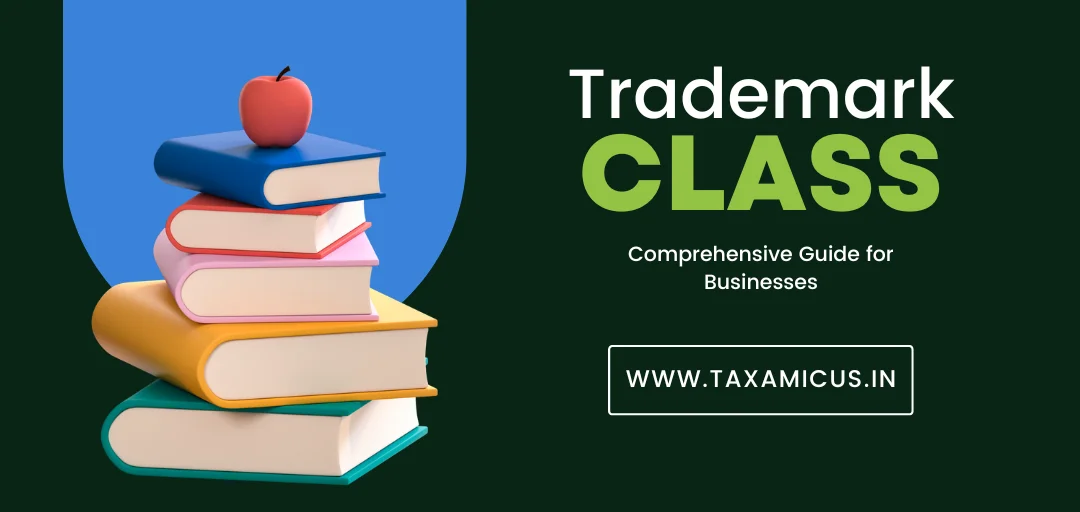Trademark registration is a critical step in protecting your brand identity. However, to register your trademark effectively, it is crucial to understand the concept of a trademark class. This classification system organizes various goods and services into 45 different categories to streamline the trademark registration process and avoid confusion between similar brands operating in different industries.
In this blog, we will delve into the importance of a trademark class, explain each class in detail, and discuss why registering your trademark under the appropriate class is essential for safeguarding your business interests.
What is a Trademark Class?
A trademark class is a category defined under the Nice Classification (NCL), an internationally recognized system used to group goods and services into 45 distinct categories. These classes help businesses and legal authorities determine the scope of trademark protection for a specific brand.
For instance, if you own a business that manufactures cosmetics, your trademark would fall under Class 3, which covers cosmetics, soaps, and related products. Similarly, a software company would register its trademark under Class 9, which covers computer software and electronic devices.
Why is a Trademark Class Important?
Avoids Overlapping Claims
By registering your trademark under the correct class, you ensure that your brand is protected in your specific industry. This minimizes disputes with companies operating in unrelated sectors.Legal Protection
A correctly classified trademark provides robust legal protection, preventing others from using your brand identity within your class.Efficient Registration Process
Understanding trademark classes simplifies the registration process and ensures your application covers all relevant goods or services associated with your brand.Global Standardization
The Nice Classification system is recognized globally, allowing businesses to expand internationally without reclassifying their trademarks.
Detailed Explanation of Trademark Classes
Goods (Classes 1–34):
Class 1:
Chemicals used in industry and science.
This class includes industrial chemicals used for manufacturing processes and scientific research, adhesives, and raw chemicals like synthetic resins, fertilizers, and water-purifying substances. For instance, a company producing cleaning agents or biochemicals would register under this class.
Class 2:
Paints, varnishes, and preservatives.
This class encompasses products used for protection or decoration, such as industrial paints, wood preservatives, dyes, and rust preventatives. For example, companies manufacturing automotive paints or artist colors fall under this category.
Class 3:
Cosmetics and cleaning products.
This includes skincare items, soaps, perfumes, hair care products, makeup, and cleaning agents for household use. A beauty product brand or a detergent manufacturer would register here.
Class 4:
Lubricants and fuels.
Products like industrial oils, greases, candles, and fuels for vehicles and machinery belong to this class. For instance, a company selling car engine oils or wax candles would use Class 4.
Class 5:
Pharmaceuticals and medical supplies.
Medicines, dietary supplements, and items like disinfectants or sanitary products are covered here. Pharmaceutical companies or businesses making personal hygiene products would choose this class.
Class 6:
Metal goods.
This includes metal-based materials such as building components (nails, pipes), metal furniture, safes, and locks. Businesses manufacturing steel parts or construction metals fall under this category.
Class 7:
Machinery and machine tools.
Engines, agricultural machines, robots, and tools used in industrial production or construction belong to this class. For example, manufacturers of industrial sewing machines or robotic arms register here.
Class 8:
Hand tools.
Manual tools like hammers, knives, razors, and gardening tools fall into this category. Companies creating high-precision hand tools or personal grooming kits would use this class.
Class 9:
Electrical and scientific equipment.
Items like computers, smartphones, cameras, scientific measuring devices, and software applications are part of Class 9. A tech startup or a software firm would register here.
Class 10:
Medical devices.
This includes surgical instruments, diagnostic tools, orthopedic equipment, and other medical apparatus like thermometers or pacemakers.
Class 11:
Environmental control apparatus.
Products like air conditioners, water purifiers, lighting equipment, and kitchen appliances like microwaves fall here. Companies in the home appliance sector often register under Class 11.
Class 12:
Vehicles and transportation equipment.
Vehicles (cars, bicycles, airplanes), vehicle parts, and transport-related machinery belong to this class. Automotive manufacturers and spare part producers register under Class 12.
Class 13:
Firearms and explosives.
Weapons, ammunition, fireworks, and pyrotechnics are classified here. Firearms manufacturers or companies producing safety devices like flare guns use this class.
Class 14:
Jewelry and watches.
This includes luxury items like gold jewelry, engagement rings, watches, and gemstones. High-end accessory brands fall into this category.
Class 15:
Musical instruments.
Products such as guitars, violins, keyboards, and electronic music devices belong to Class 15. Musical instrument makers or retailers register here.
Class 16:
Paper goods and stationery.
This includes books, diaries, pens, educational materials, and packaging like cardboard boxes. Publishing houses or stationery brands use this class.
Class 17:
Rubber and plastic products.
Materials like insulating tape, rubber sheets, and plastic pipes belong to this class. Companies producing industrial rubber goods or polymer products use this category.
Class 18:
Leather goods.
Products like handbags, wallets, luggage, and belts fall into this class. Brands specializing in leather accessories register here.
Class 19:
Building materials.
This includes non-metallic construction materials like bricks, glass, cement, and timber. Real estate suppliers and construction companies often use this class.
Class 20:
Furniture.
Household furniture, mattresses, mirrors, and office furniture are part of Class 20. Companies making home décor items or ergonomic chairs would register here.
Class 21:
Household utensils.
Cooking tools, cleaning equipment, glassware, and dishware are categorized here. A brand specializing in cookware or cleaning brushes would use this class.
Class 22:
Ropes and textiles.
Products such as nets, tents, sails, and cords fall under this class. Manufacturers of camping gear or industrial textile suppliers use this category.
Class 23:
Yarns and threads.
Textile fibers used in knitting, weaving, or embroidery are categorized here. A yarn manufacturer would register under Class 23.
Class 24:
Fabrics and textiles.
This includes bedding, curtains, and upholstery materials. Textile brands and home décor businesses use this class.
Class 25:
Clothing and footwear.
Apparel, footwear, and headgear belong to Class 25. Fashion brands and athletic shoe companies would register here.
Class 26:
Haberdashery.
Items like buttons, zippers, and ribbons fall under this category. Suppliers of garment accessories use Class 26.
Class 27:
Floor coverings.
Products such as carpets, rugs, and mats are part of this class. Home furnishing brands register here.
Class 28:
Toys and sporting goods.
Board games, sporting equipment, and outdoor toys belong to Class 28. A brand specializing in fitness or play equipment would use this class.
Class 29:
Food products.
This includes dairy, meat, and frozen foods. Food processing companies and dairy brands use Class 29.
Class 30:
Staple foods.
Items like bread, pasta, spices, and coffee fall here. Bakeries and spice manufacturers register under Class 30.
Class 31:
Raw agricultural products.
Fresh fruits, vegetables, and seeds belong to this class. Agricultural exporters or organic produce sellers use this category.
Class 32:
Beverages (non-alcoholic).
Juices, mineral water, and soft drinks are part of Class 32. Beverage manufacturers use this category.
Class 33:
Alcoholic beverages.
This includes wine, beer, and spirits. Alcohol brands and wineries register here.
Class 34:
Tobacco products.
Cigarettes, cigars, and smoking accessories are categorized here. Tobacco companies use Class 34.
Why Registering Under the Right Trademark Class is Crucial
Registering your trademark under the correct trademark class is important to:
- Prevent Infringement: Proper classification prevents others in the same industry from using a similar brand name.
- Expand Your Brand: A registered trademark offers credibility, making it easier to expand into new markets.
- Legal Recourse: In case of disputes, a trademark registered under the right class ensures you have the upper hand in legal proceedings.
Conclusion
Understanding and registering your trademark under the appropriate trademark class is essential for protecting your brand. With 45 classes covering a vast range of goods and services, ensuring the right classification can save you from legal disputes and boost your brand’s credibility.
Whether you’re a business owner, an artist, or a service provider, trademark registration is a valuable investment. Consulting a trademark expert can simplify the process and ensure your brand enjoys maximum protection under the law.
Our Trademark Services

Trademark Registration
Trademark registration is the process of legally securing exclusive rights to a brand name, logo, or slogan, protecting it from unauthorized use and ensuring nationwide recognition for the owner.

Trademark Objection
Trademark objection occurs when the registrar raises concerns or questions regarding a trademark application, typically due to potential conflicts with existing marks or lack of distinctiveness.

Trademark Opposition
Trademark opposition allows third parties to challenge a pending trademark application, typically because they believe it may conflict with their own brand rights or cause market confusion.





